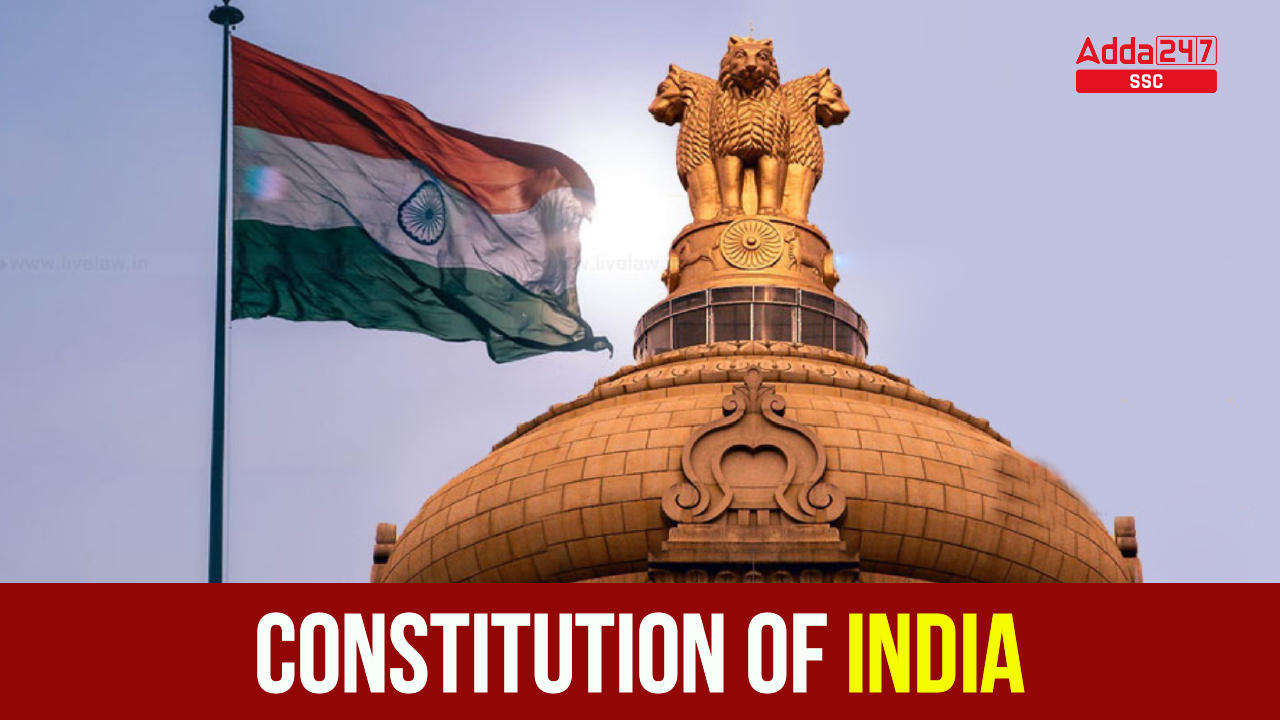Table of Contents
Constitution of India
The Indian Constitution: The Bharatiya Samvidhan, also known as the Constitution of India, is the country’s paramount legal text. It lays the groundwork for India’s political laws, organizational structure, procedures, and delineates the responsibilities and powers of its governmental entities.
Crafted by B. R. Ambedkar, the “Father of the Indian Constitution,” it was adopted on November 26, 1949, and came into effect on January 26, 1950 (Republic Day). Initially comprising 395 articles in 22 parts and 8 schedules, it has seen 105 amendments. Explore the key features of the Indian Constitution India boasts the world’s lengthiest constitution, divided into 25 parts and 12 schedules. .
Features Of Indian Constitution
Here are some key features of the Indian Constitution:
1. Preamble: The Constitution begins with a preamble that outlines the aims and aspirations of the people of India. It emphasizes justice, liberty, equality, and fraternity – guiding principles for the nation.
2. Lengthiest Written Constitution: India has one of the lengthiest written constitutions worldwide. It’s like a detailed guide that tells us how the country should be run and how things should work.
3. Parliamentary System: India follows a parliamentary system of government where the President is the head of state, and the Prime Minister is the head of government. The Council of Ministers is responsible to the Lok Sabha (House of the People).
4. Emergency Provisions: The Constitution includes provisions for the declaration of a state of emergency in the event of war, external aggression, or armed rebellion, granting the government temporary extraordinary powers.
5. Fundamental Rights: The Constitution guarantees fundamental rights to Indian citizens, including the right to equality, freedom of speech, right to life, and protection against discrimination.
6. Directive Principles of State Policy: The Directive Principles of State Policy provide guidelines for the government to achieve social and economic justice. While not enforceable by courts, these principles are fundamental in policy-making.
7. Fundamental Duties: Added through the 42nd Amendment in 1976, the Constitution includes fundamental duties that citizens should uphold for the integrity and prosperity of the nation.
8. Independent Judiciary: The Constitution establishes an independent judiciary with the Supreme Court at the apex. It has the power of judicial review to ensure the constitutionality of laws and acts as a guardian of fundamental rights.
9. Secularism: India is a secular state, ensuring that there is no official state religion. Every citizen has the right to practice and promote the religion of their choice.
10. Reservation Policies: The Constitution allows for the reservation of seats in educational institutions and government jobs for socially and economically backward classes, as well as Scheduled Castes and Scheduled Tribes.
Parts Of Indian Constitution
| Part | Subject | Articles |
|---|---|---|
| Part I | The Union and its territory | Art. 1 to 4 |
| Part II | Citizenship | Art. 5 to 11 |
| Part III | Fundamental Rights | Art. 12 to 35 |
| Part IV | Directive Principles | Art. 36 to 51 |
| Part IVA | Fundamental Duties | Art. 51A |
| Part V | The Union
Chapter I – The Executive (Art.52 to 78)
Chapter II – Parliament (Art.79 to 122)
Chapter III – Legislative Powers of President (Art.123)
Chapter IV – The Union Judiciary (Art. 124 to 147)
Chapter V – Comptroller and Auditor-General of India (Art.148 to 151)
|
Art. 52 to 151 |
| Part VI | The States
Chapter I – General (Art.152)
Chapter II – The Executive (Art.153 to 167)
Chapter III – The State Legislature (Art.168 to 212)
Chapter IV – Legislative Powers of Governor (Art.213)
Chapter V – The High Courts (Art.214 to 232)
Chapter VI – Subordinate Courts (Art.233 to 237)
|
Art. 152 to 237 |
| Part VII | States in the B part of the First Schedule Repealed by Const. (7th Amendment) Act, 1956 |
|
| Part VIII | The Union Territories | Art. 239 to 242 |
| Part IX | The Panchayats | Art. 243 to 243O |
| Part IXA | The Municipalities | Art. 243P to 243ZG |
| Part IXB | Co-operative Societies | Art. 243H to 243ZT |
| Part X | The Scheduled and Tribal Areas | Art. 244 to 244A |
| Part XI | Relations between the Union and the States
Chapter I – Legislative Relations (Art.245 to 255)
Chapter II – Administrative Relations (Art.256 to 263)
|
Art. 245 to 263 |
| Part XII | Finance, Property, Contracts, and Suits
Chapter I – Finance (Art.264 to 291)
Chapter II – Borrowing (Art.292 to 293)
Chapter III – Property, Contracts, Rights, Liabilities, Obligations and Suits (Art.294 to 300)
Chapter IV – Right to Property (Art.300-A)
|
Art. 264 to 300A |
| Part XIII | Trade, Commerce, and Intercourse within the Territory of India | Art. 301 to 307 |
| Part XIV | Services under the Union and the States | Art. 308 to 323 |
| Part XIVA | Tribunals | Art. 323A to 323B |
| Part XV | Elections | Art. 324 to 329A |
| Part XVI | Special provisions relating to certain classes | Art. 330 to 342 |
| Part XVII | Official Language
Chapter I – Language of the Union (Art.343 to 344)
Chapter II – Regional Languages (Art.345 to 347)
Chapter III-Language of the Supreme Court, High Courts, and so on (Art.348 to 349)
Chapter IV-Special Directives (Art.350 to 351)
|
Art. 343 to 351 |
| Part XVIII | Emergency Provisions | Art. 352 to 360 |
| Part XIX | Miscellaneous | Art. 361 to 367 |
| Part XX | Amendment of the Constitution | Art. 368 |
| Part XXI | Temporary, Transitional, and Special Provisions | Art. 369 to 392 |
| Part XXII | Short title, commencement, authoritative text in Hindi, and repeals | Art. 393 to 395 |
Indian Constitution Schedules
| Schedule | Contents |
|---|---|
| First Schedule | The list of states and union territories along with their territories. |
| Second Schedule | Provisions related to the President, Governors of States, Speaker and Deputy Speaker of the House of the People, Chairman and Deputy Chairman of the Council of States, and more. |
| Third Schedule | The Forms of Oaths or Affirmations. |
| Fourth Schedule | Provisions regarding the allocation of seats in the Council of States. |
| Fifth Schedule | Provisions related to the Administration and Control of Scheduled Areas and Scheduled Tribes. |
| Sixth Schedule | Provisions related to the Administration of Tribal Areas in the States of Assam, Meghalaya, Tripura, and Mizoram. |
| Seventh Schedule | The Union list, State list, and the concurrent list. |
| Eighth Schedule | The list of recognized languages. |
| Ninth Schedule | Provisions related to the validation of certain Acts and Regulations. |
| Tenth Schedule | Provisions related to disqualification on the ground of defection. |
| Eleventh Schedule | The powers, authority, and responsibilities of Panchayats. |
| Twelfth Schedule | (Added by the 74th Amendment Act of 1992) The powers, authority, and responsibilities of Municipalities. |
Articles In Indian Constitution
The fundamental rights, enshrined in the Indian Constitution, play a crucial role in protecting the rights and liberties of every citizen. They are covered by Articles 12 to 35. Here is a comprehensive list of fundamental rights along with their corresponding articles:
| S.No | Fundamental Right | Article of Constitution |
| 1 | Right To Equality (Article 14 to 18) |
Art. 14- Equality Before Law |
| Art. 15- Prohibition of discrimination on grounds of religion, race, caste, sex or place of birth | ||
| Art. 16- Equality of Opportunity in public employment | ||
| Art. 17- Abolition of untouchability | ||
| Art. 18- Abolition of Titles | ||
| 2 | Right To Freedom (Article 19 to 22) |
Art 19- Freedom of speech, expression, movement |
| Art 20- Protection from a conviction for offenses | ||
| Art 21- Right to Life & Personal Liberty | ||
| Art 22- Protection against arrest or detention | ||
| 3 | Right Against Exploitation (Article 23 & 24) |
Art 23- Protection from Trafficking & Forced Labour |
| Art 24- Ban on child labor | ||
| 4 | Right To Freedom of Religion (Article 25 to 28) |
Art 25- Freedom to practice one’s own religion |
| Art 26- Freedom to manage religious affairs | ||
| Art 27- No taxation for the promotion of religion | ||
| Art 28- Freedom as to attendance at religious instruction or religious worship in institutions | ||
| 5 | Cultural & Educational Rights (Article 29 & 30) | Art 29- To Protect & Preserve the Minorities |
| Art 30- Right of minorities to administer educational institutions | ||
| 6 | Right To Constitutional Remedies (Article 32) | Art 32- Remedies for enforcement of rights |
The Supreme Court has reaffirmed its judgment in the Menaka case in the subsequent cases. It has declared the following rights as part of Article 21:
(1) Right to live with human dignity.
(2) Right to a decent environment including pollution-free water and air and protection against hazardous industries.
(3) Right to livelihood.
(4) Right to privacy.
(5) Right to shelter.
(6) Right to health.
(7) Right to free education up to 14 years of age.
(8) Right to free legal aid.
(9) Right against solitary confinement.
(10) Right to a speedy trial.
(11) Right against handcuffing.
(12) Right against inhuman treatment.
(13) Right against delayed execution.
(14) Right to travel abroad.
(15) Right against bonded labor.
(16) Right against custodial harassment.
(17) Right to emergency medical aid.
(18) Right to timely medical treatment in a government hospital.
(19) Right not to be driven out of a state.
(20) Right to a fair trial.
(21) Right of a prisoner to have necessities of life.
(22) Right of women to be treated with decency and dignity.
(23) Right against public hanging.
(24) Right to hearing.
(25) Right to information.
(26) Right to reputation.
(27) Right of appeal from a judgment of conviction
(28) Right to social security and protection of the family
(29) Right to social and economic justice and empowerment
(30) Right against bar fetters
(31) Right to appropriate life insurance policy
(32) Right to sleep
(33) Right to freedom from noise pollution
(34) Right to electricity
Indian Constitution: Important Amendments
There are a total of 104 amendments to date since the inception of the Constitution in 1950.
| Amendment | Details |
|---|---|
| The Constitution (First Amendment) Act, 1951 | Changes to the Fundamental Rights provisions of the constitution |
| The Constitution (Second Amendment) Act, 1952 | Amended Article 81 in order to remove the prescribed limit of 7,50,000 of the population for one member to be elected to the Lok Sabha. |
| The Constitution (Third Amendment) Act, 1954 | Changes in the Seventh Schedule consisting of the three Legislative Lists and entry 33 of the Concurrent List were substituted by a new one. |
| The Constitution (Fourth Amendment) Act, 1955 | Articles 31 and 31A were amended |
| The Constitution (Fifth Amendment) Act, 1955 | amended Article 3 |
| The Constitution (Seventh Amendment) Act,1956 | This amendment was designed to implement the State Reorganisation Act. |
| The Constitution (Ninth Amendment) Act, 1960 | It provided for the transfer of certain territories of India to Pakistan under an agreement between India and Pakistan |
| The Constitution (Tenth Amendment) Act, 1961 | The Tenth Amendment integrates the areas of Free Dadra and Nagar Haveli with the Union of India |
| The Eleventh Amendment, 1962 | Election of Vice President by Electoral College consisting of members of both Houses of Parliament, instead of election by a Joint Sitting of Parliament. |
| The Twelfth Amendment, 1962 | incorporated the territories of Goa, Daman, and Diu in the Indian Union. |
| The Thirteenth Amendment, 1962, | created Nagaland as a state of the Union of India. |
| The Fifteenth Amendment, 1963 | Raise the retirement age of High Court judges from 60 to 62 and other minor amendments |
| The Twenty-first Amendment, 1967 | included Sindhi as the 15th regional language in the Eighth Schedule. |
| The Twenty-sixth Amendment, 1971 | Abolished the titles and special privileges of former rulers of princely states. |
| The Thirty-first Amendment, 1973 | Increased the elective strength of the Lok Sabha from 525 to 545. |
| The Thirty-sixth Amendment 1975 | Made Sikkim a state of the Indian Union. |
| The Thirty-eighth Amendment 1975 | Provided that the President can make a declaration of emergency |
| The Forty-second Amendment 1976 |
|
| The Forty-fourth Amendment 1978 |
|
| The Forty-fifth Amendment 1980, | Extended reservation for SC/ST by an additional 10 years (up to 1990). |
| The Fifty-second Amendment 1985, | Inserted the Tenth Schedule in the Constitution regarding provisions for disqualification on the grounds of defection. |
| The Fifty-sixth Amendment 1987 | The Hind version of the Constitution of India was accepted for all purposes statehood was conferred on the UT of Goa. |
| The Sixty-first Amendment 1989 | Reduced the voting age from 21 years to 18 years for the Lok Sabha as well as the Assemblies. |
| The Seventy-third Amendment 1992 (Panchayat Bill) |
Seeks to provide, among other things, Gram Sabha in villages, the constitution of Panchayats at the village and other levels, direct elections to all seats in Panchayats and reservation of seats for SC and ST, and fixing of tenure of 5 years for Panchayats. |
| The Seventy-fourth Amendment, 1993 (Nagarpalika Bill) |
Provides for, among other things, the constitution of three types of municipalities and the reservation of seats in every municipality for the SC/ST, women, and the OBCs |
| The Eighty-sixth Amendment 2002 |
|
| The Eighty-ninth Amendment 2003 | Provides for the Amendment of Article 338 |
| The Ninety-first Amendment 2003 | Provides for the Amendment of Article 75. |
| The Ninety-Second Amendment 2004 | Include Bodo, Dogri, Santali, and Maithili as official languages. |
| The Ninety-Third Amendment 2006 | Reservation (27%) for Other Backward Classes(OBC) in government as well as private educational institutions. |
| The Ninety-Ninth Amendment 2015 | Formation of a National Judicial Appointments Commission |
| The One-Hundredth Amendment 2015 | The term the Constitution (100th Amendment) Act, 2015 was in news in the fourth week of May 2015 as the President of India Pranab Mukherjee gave his assent to the Constitution (119th Amendment) Bill, 2013 that related to the Land Boundary Agreement (LBA) between India and Bangladesh |
| The One Hundredth One Amendment 2017 | Introduced the Goods and Services Tax |
| One Hundred and Third Amendment Act 2019 | Introduces 10% reservation for economically weaker sections of society for admission to Central Government-run educational institutions and private educational institutions |
| The Constitution (104th Amendment) Act 2020 | It extended the reservation of seats for SCs and STs in the Lok Sabha and state assemblies. |



 Govt Jobs 2024, Latest Upcoming Governme...
Govt Jobs 2024, Latest Upcoming Governme...
 Upcoming Government Exams, Complete Govt...
Upcoming Government Exams, Complete Govt...
 RPF Constable Recruitment 2024 Notificat...
RPF Constable Recruitment 2024 Notificat...






